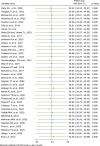Healthcare providers' pain management practice and its associated factors in Ethiopia: A systematic review and meta- analysis
- PMID: 39565805
- PMCID: PMC11578494
- DOI: 10.1371/journal.pone.0309094
Healthcare providers' pain management practice and its associated factors in Ethiopia: A systematic review and meta- analysis
Abstract
Introduction: Pain is defined as an unpleasant sensory and emotional experience associated with actual or potential tissue damage. Under -treatment of pain continues to be a major health care problem in Ethiopia. Although it has this problem, it receives limited research attention. This systematic review and meta-analysis will provide valuable insights of prevalence and its factors of healthcare providers' pain management practice in Ethiopia.
Methods: This systematic review and meta-analysis followed Preferred Reporting Items for Systematic Reviews and Meta-Analyses guidelines. Universal online databases such as PubMed, Cochrane, Google, Google Scholar, SCOPUS, Web of Science and Global Health were used to search for articles. Microsoft Excel for data extraction and STATA17 for data analysis were used. DerSimonian and Laird random-effects model was used to pool the odds ratios across studies and compute the overall pooled prevalence and its predictors. Egger's test with funnel plot symmetry and Cochrane's Q test was used to assess publication bias and heterogeneity respectively.
Results: The overall pooled prevalence of health care providers' pain management practice was 39.6% (95% CI: 34.8, 44.5); I2 = 97.0%; P<0.001). Availability of pain management protocol (AOR = 5.1, 95%CI: 3.6, 6.7), Accessibility of analgesia (AOR = 4.5, 95%CI: 1.96, 7.0), higher educational level (AOR = 3.3, 95%CI: 2.5, 4.1), being female (AOR = 1.2, 95% CI: 1.6, 3.1), took training (AOR = 2.7, 95% CI: 1.8, 3.6), decreased work load (AOR = 4.9, 95% CI: -1.9, 11.7), increased work experience (AOR = 3.9, 95% CI: 2.9, 5.1), Being midwifery profession (AOR = 2.5,95% CI: 1.6, 3.4), having good attitude (AOR = 3.9,95%CI: 2.5, 5.4) and being knowledgeable (AOR = 4.2, 95%CI: 2.8, 5.6) of health care providers towards pain management practice were significantly associated in Ethiopia.
Conclusion: The overall prevalence of pain management practice among healthcare providers in Ethiopia is low compared with a national target of pain free hospital initiatives in Ethiopia. It needs a call to build health care providers' ongoing education, training, professional development and manageable workload.
Copyright: © 2024 Kefale et al. This is an open access article distributed under the terms of the Creative Commons Attribution License, which permits unrestricted use, distribution, and reproduction in any medium, provided the original author and source are credited.
Conflict of interest statement
The authors have declared that no competing interests exist.
Figures




References
-
- Imoro M.A., Practice of pain assessment in critically Ill patients among nurses at the tamale teaching hospital. Diverse Journal of Multidisciplinary Research, 2019. 1(1): p. 1–6.
-
- Cervero F., Understanding pain: exploring the perception of pain. 2012: Mit Press.
Publication types
MeSH terms
LinkOut - more resources
Full Text Sources
Medical
Miscellaneous

